
Governments’ response to COVID-19 From pandemic crisis to a better future
30 minute read
16 April 2020
Government's response to this crisis must account for the urgency of the situation and embrace both short- and long-term perspectives.
A timeline of governments’ actions through the COVID-19 crisis
The rapid spread of the COVID-19 virus is challenging governments to act in ways normally reserved for war, depressions, and natural disasters. The pandemic has caused global upheaval that may endure for months—or longer. Governments are taking extreme measures to limit the human cost and economic disruption. It is the most consequential set of public policy and mass behavior change actions most of us have seen in our lifetimes.
Learn more
Read the executive summary
Learn more about connecting for a resilient world
Learn about Deloitte’s services
Go straight to smart. Get the Deloitte Insights app
In a fast-moving crisis, as information swarms in from every direction, citizens look to their governments for information, guidance, and leadership. They expect to be kept safe and healthy. Pressure on public officials to act is enormous. How can they hope to gain clarity amid chaos? How can they move from ad hoc solutions to a well-planned path to recovery? And, as we eventually emerge from the crisis, how can they ensure more resilient, effective responses in the future?
This study considers how governments should think about short- and long-term responses to the COVID-19 crisis. Rather than offering specific policy recommendations, we’ll look at how governments can structure their decision-making to address the challenges they face.
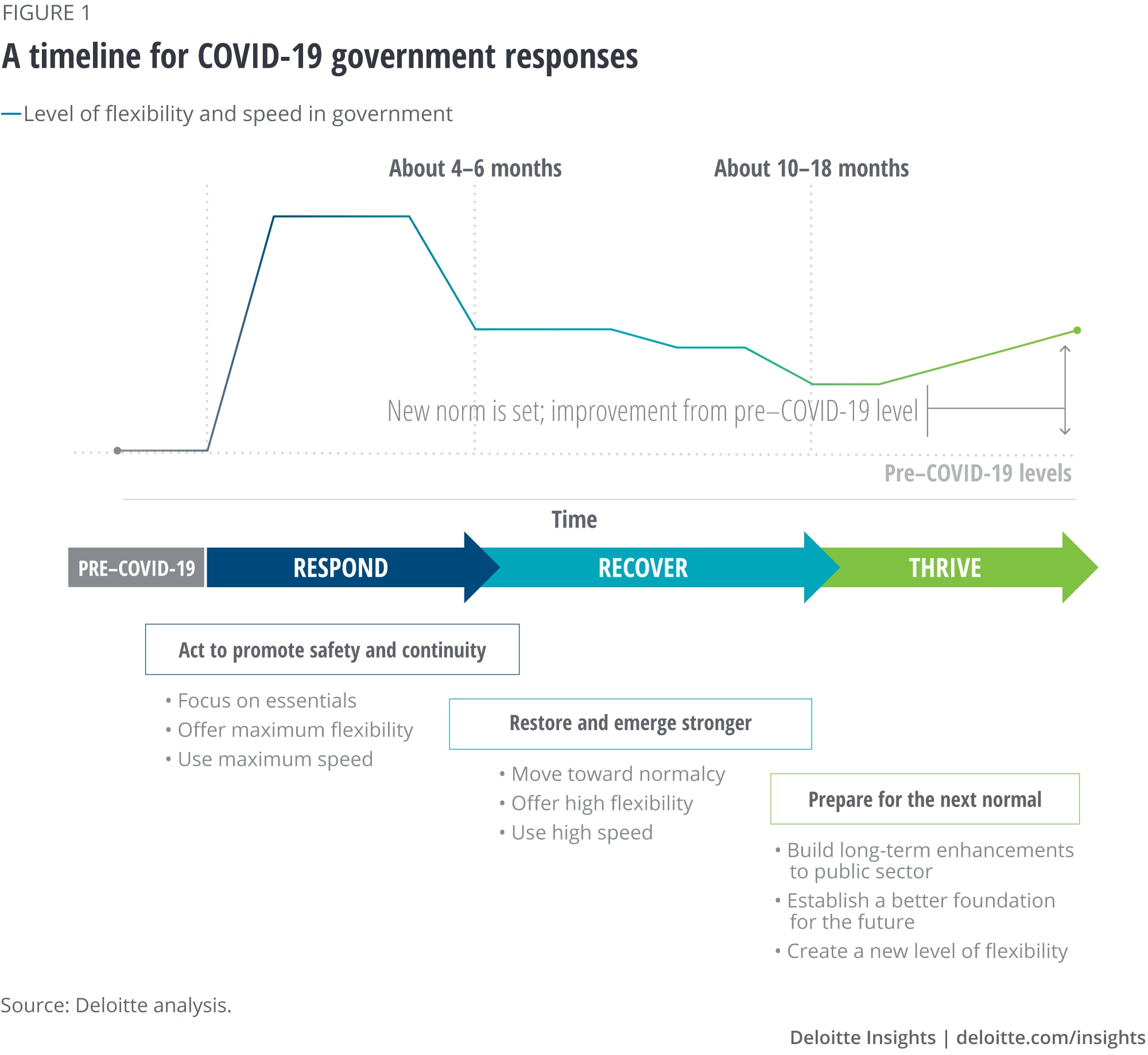
Figure 1 models the COVID-19 crisis over time across the three overlapping phases governments will pass through: Respond, Recover, and Thrive. Ideally, we would be able to predict the dates of transition from one phase to the next. But as the United States’ Dr. Anthony Fauci has said, “You don’t make the timeline, the virus makes the timeline.”1 Different parts of the world will be hit at different times and with varying severity. Robust data analysis through all phases will be vital so officials can properly interpret the signals and act accordingly.
Respond: At this writing (mid-April 2020), most governments are in the Respond phase. They are dealing with an immediate crisis. Governments are moving fast and bypassing many typical procedures: ordering business closures, curtailing travel, reallocating industrial capacity to meet urgent medical needs, and providing immediate financial assistance. Some countries, mostly in the southern hemisphere, have yet to experience the crisis.
Recover: As the immediate danger eases, governments will enter the Recover phase, shifting their focus to steepening the curve of the economic recovery and to mitigating the broader impacts of the crisis. Public institutions will begin to return to normal. Government will still move swiftly, possibly shortcutting some traditional controls, but with fewer unilateral executive actions.
Thrive: Having survived the crisis, governments will consider long-term improvements to public operations—to ensure they can respond effectively to future risks by becoming more digital, revisiting supply chains, and monitoring for future pandemics. Old rules and regulations should be reevaluated, allowing technologies that have shown their effectiveness during the crisis—such as telehealth and remote work—to become permanent options in government.
While each government will find its own unique path throughout the three phases, all will likely face common challenges, including the efforts needed to become better prepared for the next crisis.
At each phase, government’s guiding metric should be its impact on people. In the short term, this means a focus on containment, treatment, and economic survival. In the medium term, the goal will shift toward economic recovery and a return to normal conditions. In the long term, we should hope to emerge better prepared to adapt to this—or any—type of crisis, and better positioned to promote the well-being of our citizens.
The journey through crisis will deal with three challenges
Governments will contend with the consequences of COVID-19 on three fronts (figure 2).
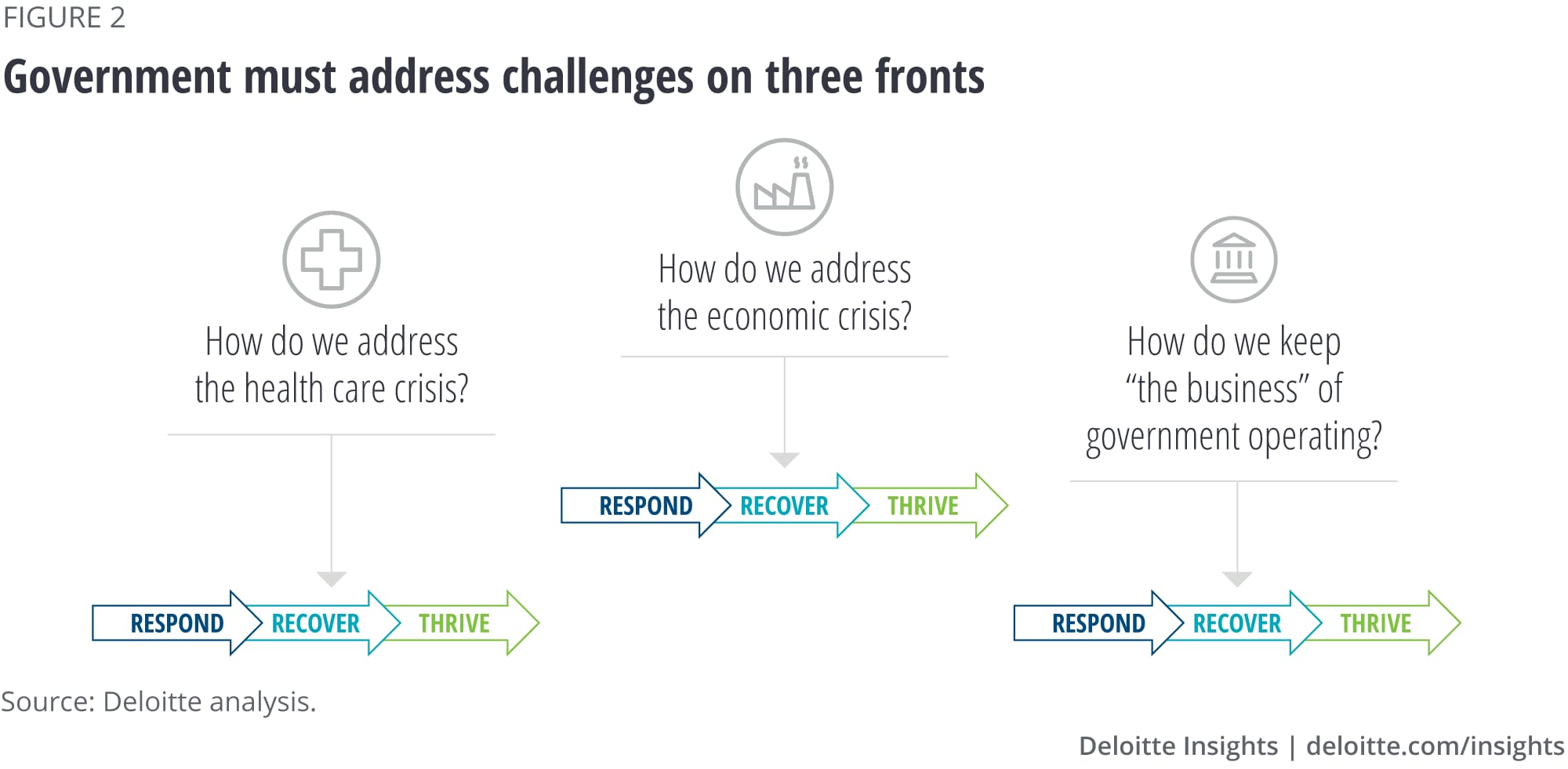
Any given government agency may be involved with one, two, or all three fronts. During the Respond phase, for instance, a transit agency may limit ridership, enforce social distancing, and regularly disinfect vehicles while monitoring employee health. Later, the agency may play a part in the Recover and Thrive phases by spending stimulus money on new equipment. Throughout all phases, the day-to-day business of running vehicles, despite revenue shortfalls, must continue. Figure 3 shows how activities on various fronts will likely change over time.
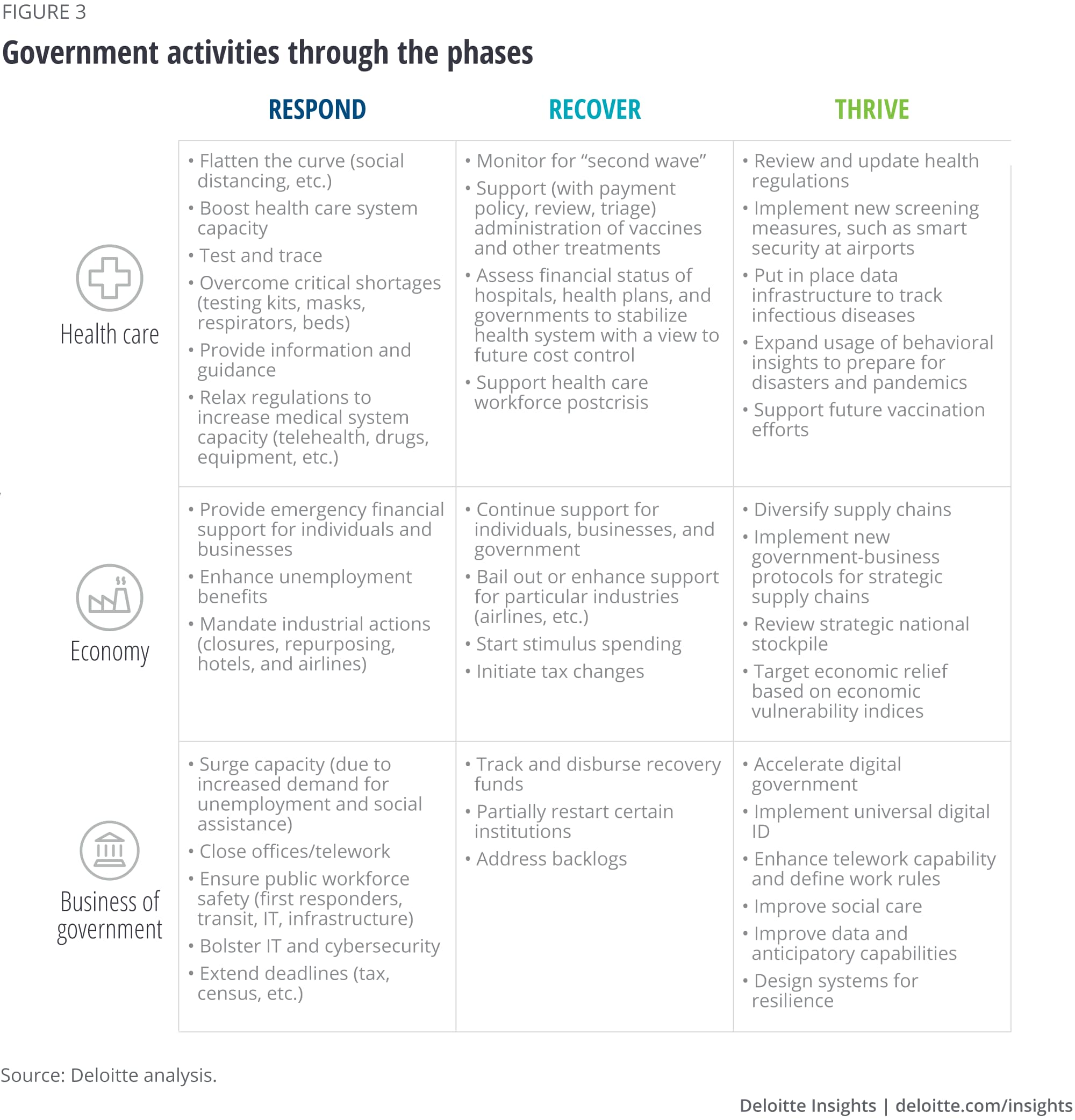
So far, governments have been dealing primarily with urgent medical and economic issues. As the weeks pass, the pressure to restore day-to-day government operations will grow, and currently shuttered services (schools, libraries, licensing offices, and so on) will need to move into Recovery and, ultimately, the Thrive phase. The final phase, however, should not be a simple return to business as usual, but a new normal appropriate to a new environment.
Each phase will be characterized by change, some of it unpredictable. Governments must be adaptable as circumstances evolve, including heeding data signals that indicate a resurgence of the virus.
Figure 4 shows how data-driven signals may shift government responses within each phase.

Respond: Even when guided by data, decisions will involve uncertainty
The COVID-19 response is especially challenging due to three characteristics that set it apart from most disasters. First, the crisis will unfold over an extended period. In most natural disasters, the event itself is complete in minutes or hours. COVID-19 is a slow-motion disaster rolling out over weeks and months.
Secondly, this is a global disaster; every region is affected, making it difficult to shift resources from unaffected areas. Fortunately, lessons learned—and treatments developed—in one region can be applied by those who follow a later timeline.
Finally, as a novel RNA virus, COVID-19 has a high degree of uncertainty regarding timing, spread, and ultimate effects. Much remains unknown, and official estimates of the virus’s impact, duration, and possible recurrence vary.
Despite such uncertainty, the Respond phase calls for rapid, decisive action—which we have seen. Figure 5 shows a schematic of some of the ways in which the pandemic has altered various types of activities, ranging from massive surges to near total shutdowns.
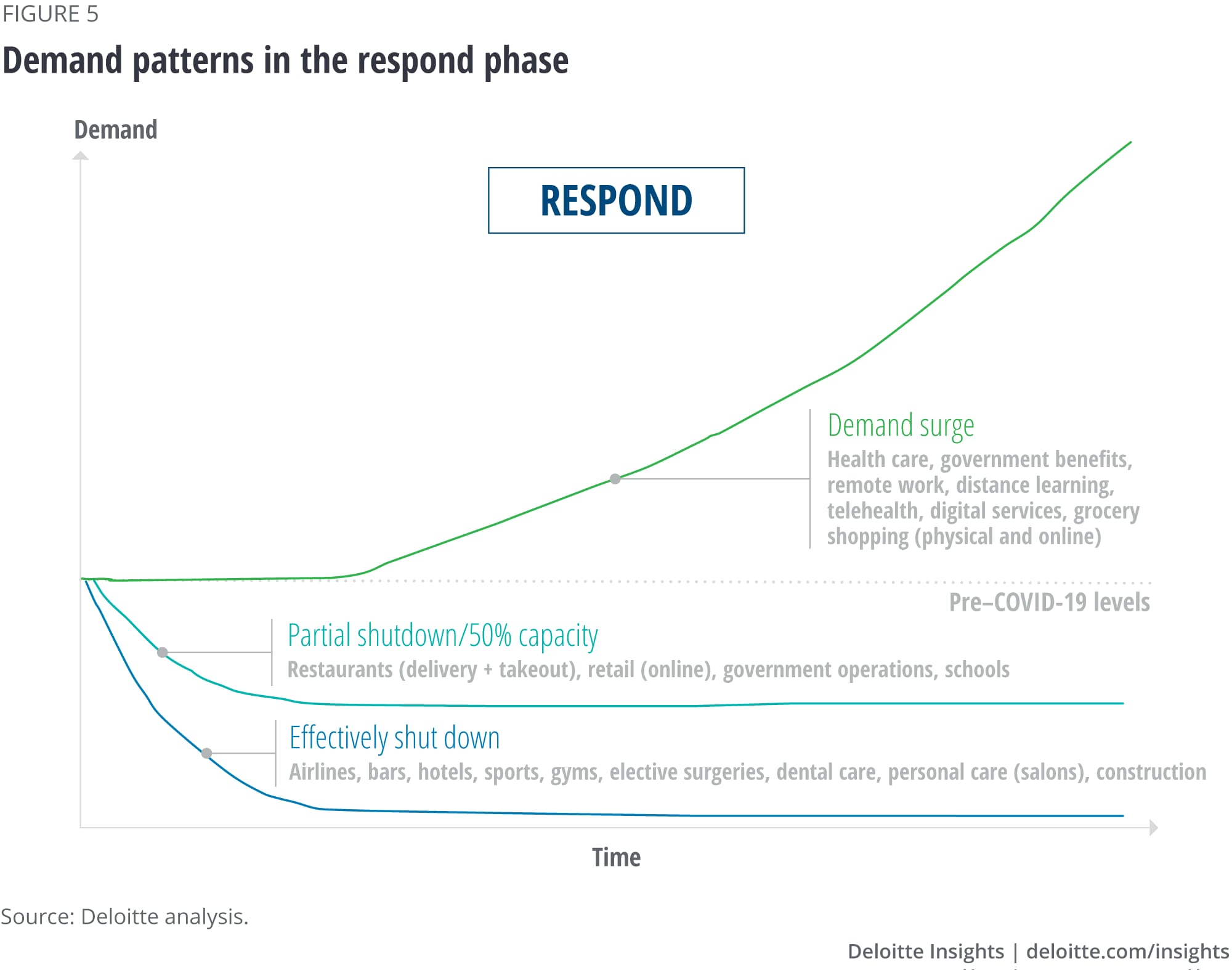
Through this phase, governments should monitor local and global health data including key indicators such as new cases, hospitalization levels, and treatment responses. Data can guide officials when to move from Respond to Recover. Governments should also recognize that the transition may occur at different times in different locales—and may even need to be suspended or reversed, as happened in Singapore in April.
Respond: The health care front
The goal of health care is to save lives. One way to do that is to slow the virus’s spread to prevent the pandemic from overwhelming medical capacity, and much has been written about “flattening the curve” through social distancing and other measures. But it may also be possible to increase health care capacity over time, such as by turning hotels into temporary hospitals or by shortening the time required for in-hospital treatment (figure 6).
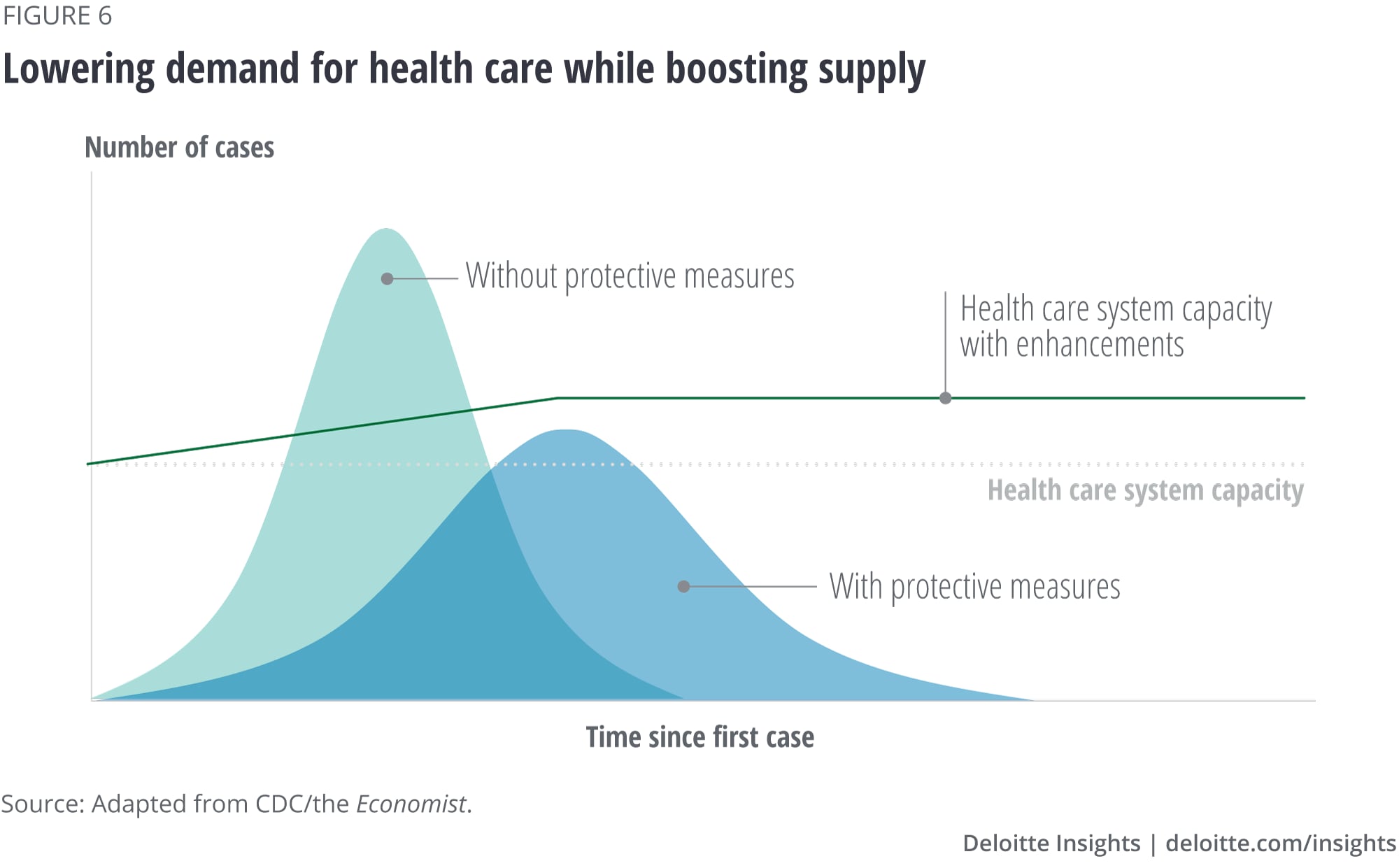
Governments can adopt appropriate policies that both flatten the curve and boost capacity where and when appropriate.
Tools and tips
Use communication to inform and build trust. Use targeted communications to reach various audiences (millennials, vulnerable populations, and so on). Many tools, such as social media sentiment analysis, can gauge the effectiveness of communications and allow for adaptive improvements.
Social distancing. Nearly all countries have adopted some form of social distancing policy to reduce the speed of transmission and allow the health care system to plan resources for helping people with severe effects.
Mass testing. Widespread mass testing, both for the disease and for immunity, will be essential to understanding how the disease is spreading and planning resources for treatment. It is also critical for information about the degree of “herd immunity” to the disease. South Korea has been a leader in this area, and Iceland has committed to testing 13 percent of the population.2 In larger countries, testing is likely to be a massive, resource-intensive effort. The development of cheaper, faster test kits, including at-home test kits, could make a big difference in this area.
Digital tools and contact tracing. In early phases of the epidemic, public health authorities can also employ contact tracing to identify people who have come into contact with those who are infected. To speed its recovery from SARS, Singapore used innovative digital technologies. To screen large numbers of people, it used modified military-grade thermal scanners and strengthened its home quarantine system. At the time, Singapore also used contact tracing, which was done using logbooks distributed to health care providers, restaurants, and even taxi drivers. Given the advancements in digital technology, digital contact tracing could be used to manage the spread of future infections.3
Singapore has continued to invest in technology, recently launching an app, TraceTogether, to help authorities to track and monitor infections. Its data is shared with government agencies upon request.4 Governments will have to strike a balance between civil liberty and public health security with regards to both mass testing and contact tracing.
Relaxing certain regulations. Regulators are acting rapidly to help tackle the COVID-19 pandemic. The US Food and Drug Administration has used its Emergency Use Authorization to expedite approvals of certain tests and drugs and temporarily waived its enforcement and inspection requirements to allow companies outside the health care industry—such as automakers—to make parts for ventilators.5 The Centers for Medicare and Medicaid Services has temporarily waived certain rules to expand patient care sites, and relaxed certain requirements for the supervision of nurses and physician assistants to free up doctors’ time.6 The lessons learned in rapid risk analysis during the pandemic may spur innovations in the future of health and medical regulation.
Driving and providing incentives for rapid development of diagnostics, vaccines, therapeutics, medical equipment, and testing. Government should make it easier for organizations outside of government to accelerate scientific breakthroughs. Antibody studies, immunity determination, and vaccine development are critical elements—if not a necessary condition—of getting from Respond to Recover, but they will require coordination between government, universities, and the private sector.
Boosting health care system capacity
Figure 7 details a number of strategies for boosting health care system capacity, including:
Increase the numbers of health care professionals. With more than 5,000 of its health care professionals infected, Italy’s government brought in doctors and paramedics from China, Russia, and Cuba.7 In the United States, states are loosening medical licensing rules to mobilize qualified health care professionals.8 India has appealed to doctors to volunteer their time and skills.9 In the United States, a similar call by the state of New York resulted in 82,000 volunteers.10 To expedite credentialing, the US Federation of State Medical Boards is providing free access to its physician database.11 More than 20,000 retired staff from the United Kingdom’s National Health Service (NHS) answered a call to return to work and fight the virus.12 The Indian government is planning to enlist fifth-year medical students.13 Elsewhere, public health officials are exploring the idea of retraining specialists to help care for COVID-19 patients.14
Use technology to reduce the burden on hospitals and doctors. The Australian, Indian, and US governments are ramping up their use of telehealth technologies.15 Robots, drones, and other emerging technologies are being deployed for thermal screening, disinfection, and remote patient monitoring.16 At China’s Wuhan field hospital, robots monitor patient health, deliver meals, and even disinfect surfaces.17
Tap into internal and external networks. Governments are using internal and external networks to address the shortage of personal protective equipment (PPE). In the United States, Apple and Google have pledged donations; European fashion and textile companies are now producing masks and gear.18 In Australia, about 130 companies have agreed to ramp up PPE production.19 Even citizen volunteers are pitching in, deploying their sewing skills.20 Recognizing the importance of data collection for decision-making, more than 40 organizations have come together to form the COVID-19 Healthcare Coalition in the United States. Their initial focus is on bringing together all relevant data sources that will be critical to addressing the crisis.21

Respond: The economic front
The immediate core challenge is getting cash into the hands of businesses and individuals through direct payments and loans. In the longer term, the challenge is restarting the economy and helping those most affected by the pandemic.
What governments are doing around the world on the economic front
In recent weeks, many governments have announced emergency programs to provide both short-term and long-term economic relief. In the United States, in addition to enhancements to unemployment, direct deposits of emergency relief funds for all taxpayers below certain income thresholds are expected before the end of April; checks sent via mail may take longer.22 South Korea has announced emergency cash payments of up to 1 million won (US$820) for all families except those in the top 30 percent of income earners.23 The Canada Emergency Response Benefit (CERB) will provide CA$500 a week for up to 16 weeks to individuals eligible for employment insurance.24
Other countries are subsidizing wages. The Danish government is covering up to 75 percent of wages for salaried workers, while New Zealand is sending a one-time subsidy of about NZ$7,000 to full-time employees. Australia, Canada, and the United Kingdom have similar programs. Employers applying for subsidy schemes must retain employees and ensure complete pass-throughs of the benefit.25 Australia is also providing cash flow support of up to AU$100,000 each for small and medium-sized businesses as well as to nonprofit organizations.26
Governments also are extending support to the self-employed and contract workers—the “gig” workforce. The US emergency relief package offers unemployment insurance to the gig workforce for up to four months in addition to weekly payments of US$600 for up to four months.27 In the United Kingdom, self-employed workers have been promised a lump-sum grant of up to 80 percent of their average monthly profits.28 In addition, states and cities are taking additional actions such as banning residential evictions and foreclosures.29
Through all these economic support programs, the potential exists for improper payments, meaning that program integrity efforts will be critical.
The core operational and policy challenges include massive demand surges, staffing constraints, the need for rulemaking and retraining, and inadequate capacity for vital elements such as call centers. In the United States, for example, more than 6.6 million people filed for jobless benefits in a single week in March, the highest number in history.30
Tools and tips
Accelerate the use of digital tools. Quickly develop point solutions or single-purpose, easy-to-use apps that can address surging cash distribution needs and other benefits while eventually integrating with back-end systems. In the interest of speed, aim for minimally viable products (MVPs): What does it absolutely have to do? Then get it online—enhancements can come later.
Tap into networks. Expedite payments by asking trade associations, industry groups, community organizations, and social services agencies to identify and help the most vulnerable citizens and small businesses.31 Countries implementing wage subsidies for employers are leveraging the existing relationship between employers and affected workers to reduce the administrative burden on government.
Adopt a customer experience (CX) mindset. Governments can make navigating the emergency relief benefits less daunting. Consider a three-pronged approach: Embedding a deep understanding of business and individual needs and experiences into digital interactions; mapping the end-to-end customer experience to identify customer pain points; and rapidly adapting digital experiences based on user input. Virtual call centers may play a role given the emphasis on remote work.
Use automation in the intake stage to auto-fill forms. Convert eligibility rules into programming codes and use intelligent automation tools to assess whether applicants are eligible to receive benefits. This can reduce backlogs and make sure beneficiaries receive benefits on time.32
Respond: The business-of-government front
The Respond phase requires a “two-gear” mindset as some functions massively surge (such as emergency response and benefit programs) while others physically close down (such as licensing agencies, schools, and libraries). In the midst of uncertainty, government must ensure the safety of its workers, shift to remote work, and execute numerous response initiatives that enable government to address both the health and economic crises—a daunting task.
The core operational and policy challenges include:
- Mission review. Government must determine which functions need to operate and which continuing operations require new protocols based on COVID-19.
- Finances. Officials at the state, provincial, and local levels will in many cases have to simultaneously manage precipitous drops in tax revenues with surges in demand and, in some cases, massive infusions of money from central government.
- Remote everything. Government faces the challenge of rapidly shifting to virtual operations and service delivery. The COVID-19 pandemic has become the world’s biggest experiment in remote everything, as telework, telehealth, and distance learning are adopted at scale “on the fly” in many cases.
- Worker safety. Many parts of government must continue to function in close contact with the public—and hence with the virus. By April 4, 2020, Detroit’s police chief James Craig was one of 114 Detroit police officers to test positive, and some 500 officers were in quarantine.33 Transit, health care, corrections, and military personnel represent just some of the public workforce at risk.
- IT and cybersecurity. Demands on IT, already high, will spike due to the crisis. IT is an essential service, enabling government to respond on the health and economic fronts. At the same time, IT is needed to support telework in an environment of increasing cyberattacks.
Tools and tips
Provide the right information at the right time through the right channels. Leaders at all levels should communicate as frequently as possible in these challenging circumstances.34 Emails, chats, and texts can help, but video can help connect emotionally and build trust among a concerned and overwhelmed workforce.35
Remote work. Be considerate to the need for flexibility in work schedules due to disruptions. Pilot phishing drills to assess the workforce’s readiness against such attacks. Provide workforce with guidance on cyber hygiene to minimize the probability of insider threats.
Virtual social care. Equip caseworkers with the required devices and virtual tools to process applications, assess eligibility, and deliver services online. Provide on-demand training to caseworkers to enable them to provide high-quality social care to beneficiaries. Reassure beneficiaries about the quality of social care, and address privacy concerns through effective communication.
Adjust the rules to meet the mission. The public sector creates rules to ensure consistency and limit inappropriate exercise of discretion. In a crisis, however, these rules may actually work against the ultimate mission, and temporarily modifying rules may be beneficial. Procurement officials, for example, can tap into their toolkit to quickly award contractors to ensure timely delivery of critical supplies and services.
Leadership in the Respond phase
The current crisis requires leaders to take quick and decisive action based on the best data available, even when incomplete—and be willing to pivot to reflect new realities.
Throughout the response, leaders should communicate clearly, consistently, and constantly. Citizens are more cooperative when they understand why they are being asked to take certain steps. Government leaders naturally have differing communication styles, but a “people-first” message, supported by the best data, can foster desired behaviors while discouraging those that could do harm.
Recover: Restore, learn, and emerge stronger
The Recover phase will begin in the midst of economies facing high unemployment, an exhausted and depleted health system, plummeting tax revenues, and backlogs of demand. Given the pandemic’s complexity, recovery will likely require unprecedented levels of coordination over an extended period of time. How well governments execute the transition to recovery will have consequences for their citizens’ physical and economic health well into the future.
Government actions to limit the spread of the virus have been potent, from travel bans and social distancing measures to the mandated closing of all but essential business services. Though necessary, the economic consequence has been severe. It’s the economic equivalent of a medically induced coma.
Governments themselves have been significantly affected. Many have seen tax revenues plunge at a time when they’re most needed. Some in the public sector workforce have been put at risk as they continue to provide critical services and infrastructure.
Recovery will be variable, as different geographies adjust their timetables depending on the virus. Indeed, future waves of infection could prompt some to revert to crisis response.
Different parts of government will restore operations as needed. When they do, many will face daunting backlogs. Services related to economic need, such as unemployment and welfare, will see high demand even after the immediate crisis passes. More routine services, such as driver licensing and business permitting, will see pent-up demand from months of reduced activity (figure 8).
If there’s a silver lining, it is that the underlying economic infrastructure remains intact—the channels of commerce just need to begin flowing freely again. While great uncertainty remains, one possible scenario calls for a V-shaped recovery with the sudden economic slump followed by a sharp rebound, while others predict more of a U-shaped recovery lasting several years.36
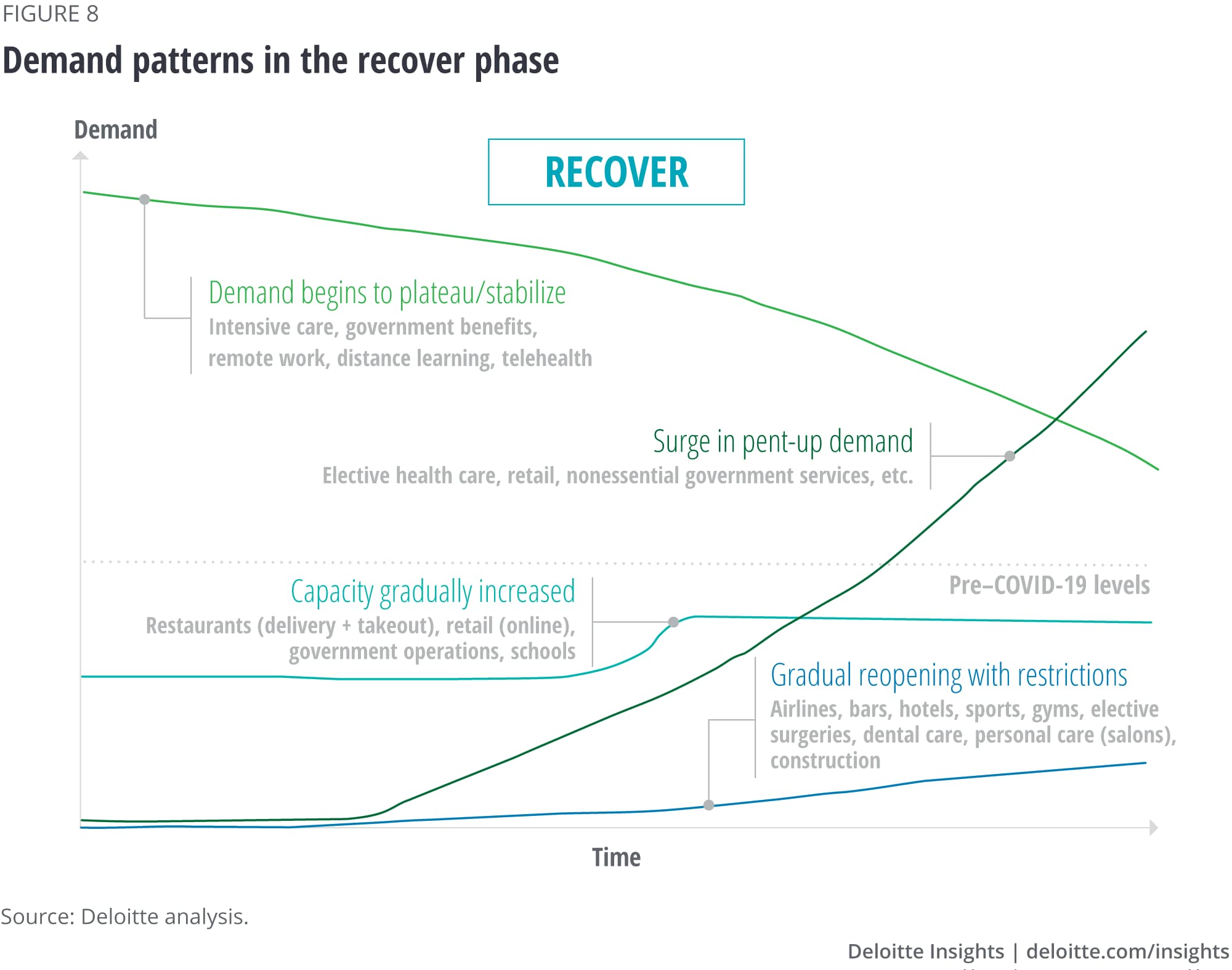
Recover: The health care front
Multiple health care challenges are likely during the Recover phase, including monitoring for possible “second wave” infections and working with companies to develop, approve, and distribute new tests, treatments, and vaccines for the virus. Health science will also be asked to rapidly identify those who have achieved immunity—either by surviving the disease, through vaccination, or otherwise—to enable safe human gatherings as soon as possible.
The medical system will also need to provide support for a traumatized medical workforce that has been through a trying ordeal. There is likely to be a surge in demand for non–COVID-19 services coming from patients who have deferred elective surgeries or otherwise postponed getting medical attention, as well as increased demand for mental health, social services, and addiction support for a distressed population. Hospitals and emergency personnel may also need training as new processes and equipment are introduced due to the virus.
The medical system will also need to assess the financial status of hospitals and health plans and provide financial support to assess losses in revenues due to COVID-19. To ensure fiscal sustainability, governments may need to identify policy levers to stabilize the health system with a view to future cost control.
Tools and tips
Scale up testing even more to be able to gain statistical insights into community exposure and identify individuals who are immune. Those who test positive can be quarantined and supported in their care remotely and kept separate from people who are neither immune nor infected. People with immunity and those who test negative for the virus could begin to resume a more normal way of life, including going back to work more rapidly.37
Develop and scale treatments and a vaccine. Scaling treatments that lessen the disease’s impact (such as antivirals or plasma from people who have recovered) and a preventive vaccine can all contribute to recovery. These treatments can allow government to safely allow individuals to return to work, travel, and gather socially, which are critical to restoring economic activity.
Conduct scenario planning. Scenario planning can help governments become better prepared for a wide range of potential challenges during the Recover phase. Taiwan’s Central Epidemic Command Center, mobilized to address the global outbreak, has a list of more than 124 action items, including identification of cases, quarantine measures, border control, and more.38 The scenarios for potential future waves of COVID-19 should be developed in coordination with industry, academia, and nongovernmental organizations that can then mobilize to support specific scenarios.
Target the most at-risk health populations. Focus on nursing home residents and other hard-hit population clusters and implement practices to strengthen those health settings through strategies such as quality improvement, community paramedicine, and telehealth—including tools to help people connect with loved ones to lessen the mental health consequences of isolation.
Determine the next phase of virtual health. Now that many health systems have pivoted to rapidly set up virtual health capabilities, how can government help them scale? What will the new normal look like for telehealth payments? Or for practicing across state or national boundaries? Government should review the risks and benefits of temporarily relaxed regulations to determine what reforms should be made permanent.
Enhance patient engagement for follow-up care. The use of virtual health and the internet of things (IoT) may offer options to increase capacity for the health care system to attend to the long-term recovery of those hit hardest by COVID-19, such as those who had been respirator-dependent.39
Develop sustained “extended” workforce strategies for health care workers. Using advanced workforce analytics and scenario planning, government can improve health systems’ ability to redeploy health professionals based upon demand. Moreover, government can explore how AI and robotics might supplement health workers so that routine COVID-19 monitoring can be done via remote sensors or by individuals themselves in their homes.
Leverage data from all sectors to support decision-making. We have seen the critical role of data analytics in combating the pandemic. Analytics will need to be deployed throughout recovery to help prevent new outbreaks. Government can leverage an array of data tools from a variety of sources, including the private sector, to inform decision-making.
Create a platform to coordinate across government and sectors. A holistic pandemic recovery requires the capability to coordinate across various levels of government, as well as with health care providers, insurers, suppliers, industry, and academia. Governance structures and efforts to promote cross-boundary collaboration will grow in importance. The experience gained here can forge a new way of working across public, private, and not-for-profit boundaries.
Recover: The economic front
The core challenge here is restarting and rebuilding the economy (figure 9). This means helping people who lost their jobs get back to work, helping businesses that were shut down to resume operations, and helping governments that have seen demand increase and revenues drop to continue to operate. In many countries, the Recover stage will likely involve stimulus packages that fund everything from physical and digital infrastructure to financial assistance for businesses and local governments.
Recovery on the economic front is intertwined with the health care front: Until people can gather in groups to work, travel, and shop, economic recovery will be limited. How do we speed recovery while limiting risk? When do we relax the rules? What restrictions still should be imposed on businesses and individuals? Should these restrictions differ by area and by industry? In most countries, the economy may not go back to normal for some time, and instead could remain in a transitional state between being fully closed and fully open.
Other challenges involve stimulus projects. What infrastructure projects would yield the biggest economic benefits? How can we limit fraud and abuse while getting money out quickly? How can we leverage government dollars with private capital to boost investment?
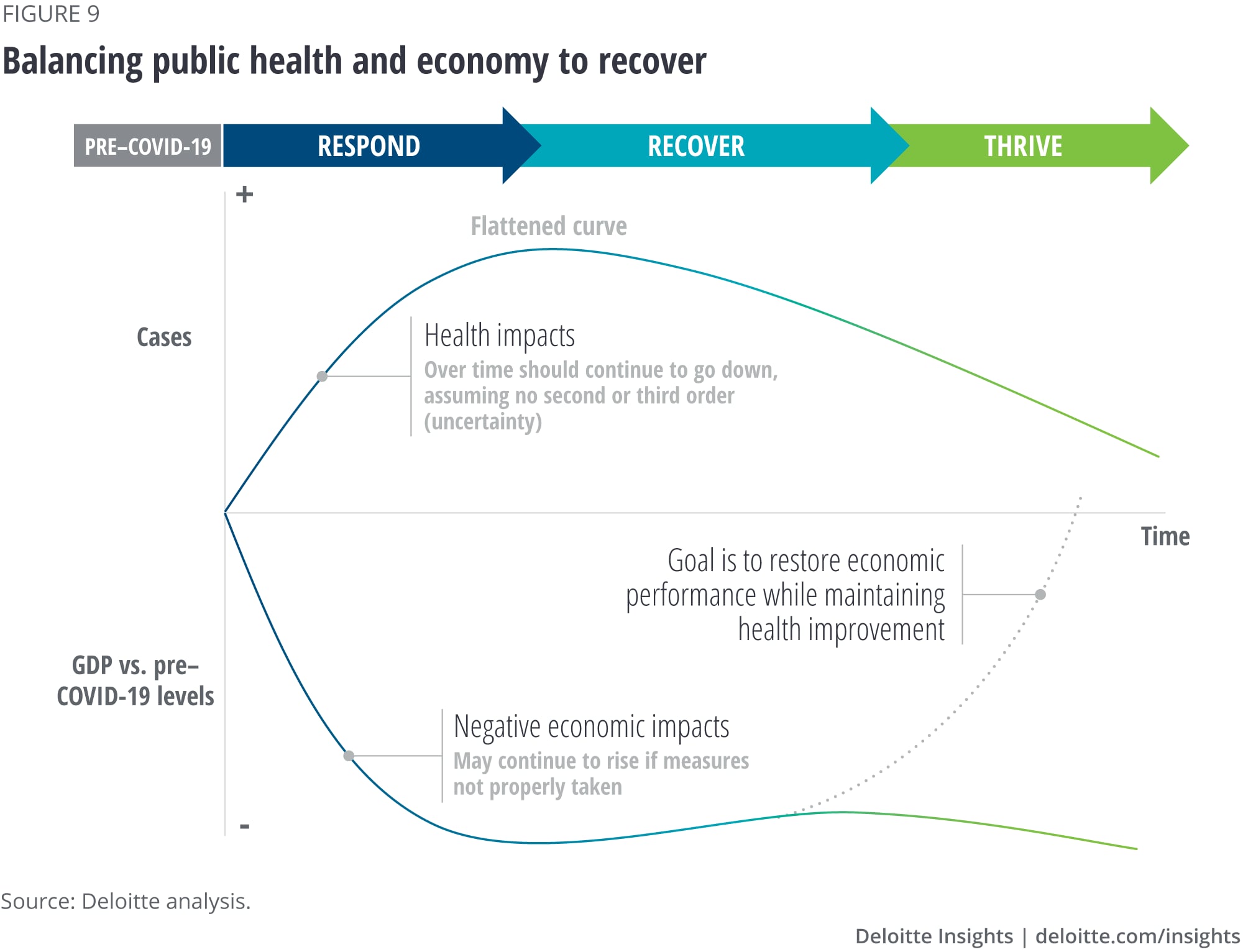
Tools and tips
Provide clear guidance for reengaging in economic and social activity. Many people will retain a fear of engaging in social and economic activity after the first wave of the virus has passed. Their willingness to engage will, in part, set the pace for economic recovery for many sectors. This will vary widely across countries and by geography within a country, as well as between different groups within a given area (for instance, “I’m afraid to leave the house” versus “I’m young so it’s no big deal for me”). Public health authorities, working with nongovernmental organizations, will need to break through the fog and provide clear guidance.
Use data to identify the hardest-hit areas. Virtually everyone has experienced the negative impact of this crisis, but some industries and some regions have been especially severely affected. It will be important to craft fair and transparent aid formulas supported by data.
Conduct an industry/sector assessment. By analyzing various sectors of the economy against their level of COVID-19 vulnerability, governments could provide more precise guidance than mere “essential” versus “nonessential” designations. Such an assessment could consider factors such as the likelihood of widespread disease transmission, a sector’s ability to mitigate against such transmissions, and so forth. This could inform decisions about which businesses can reopen and under what parameters, and provide business owners and citizens with safety guidelines. In Malaysia, for example, essential businesses in sectors such as logistics, food and beverage, and agricultural and livestock production have been allowed to continue to operate, but the Malaysian Agriculture and Food Industry Minister asked companies involved in food supply logistics to operate with reduced staffing and employee safeguards.40
Engage private sector participation to revive certain sectors. In 2004, countries hard hit by SARS collaborated with industry to revive tourism, hospitality, and other sectors. Taiwan’s government collaborated with the private sector to target three primary sources of tourists—Hong Kong, the United States, and Japan—rolling out aggressive marketing campaigns for each.41 By the end of 2004, tourism numbers were growing at a healthy 8 percent per month.42 Meanwhile, China eased visa restrictions to allow its citizens to visit Hong Kong and Macau.43
Retrofit infrastructure and civic assets. Airports, transit stations, theaters, stadiums, and other infrastructure that handles large numbers of people may need temporary design changes, as well as changes to seating arrangements, modified hours of operation, and enhanced cleaning protocols, to limit the spread of the virus.44
Evaluate supply chain vulnerability of food, supplies, medicines, and devices for life-saving care to global shocks. Run stress tests for different future scenarios, which could include subsequent waves of the pandemic or other global disruptions.
Use the power of networked government. Recovery will require a network of collaborative effort, with better integration of processes and data across agencies and departments.
Prevent fraud by design. Some improper payments will be inevitable, but with large sums being distributed so quickly, program integrity becomes key. Designing distribution to prevent improper payments and the “pay and chase” cycle can free up resources for those who truly need them. Fraud can be limited by leveraging digital processes and tools such as AI, data analytics, and nudge thinking.
Provide open data. Agencies should provide data on procurement and financial support for evaluation by researchers and the public to increase transparency and trust. Open data also can improve program integrity and help reveal fraud and abuse.45 For example, the White House’s recovery.gov, launched after the 2008 financial crisis, allowed citizens to track recovery spending.46 Partly as a result, only 2 percent of the contracts and grants awarded under the recovery act received fraud complaints, a much lower share than typical for similar efforts.47
Plan ahead for potential subsequent waves. If the virus abates and then returns in the winter in different regions of the world, countries don’t want to have to shut down the economy again. Widespread testing and tracing, along with new therapeutics, could make such retrenchments less disruptive.
Recover: The business-of-government front
Governments have been part of massive recovery efforts in the past. From World War II to the 2008 financial crisis, the business of government has had to adjust to new realities. The COVID-19 crisis is no different. In addition to each agency’s legacy mission, many or most will face additional challenges in the post-COVID environment. To further complicate matters, different agencies will enter the Recover phase after having had very different experiences during the initial response:
- Shut down: Some government functions deemed nonessential will have experienced a near-total shutdown and are likely to face huge backlogs as recovery commences. Functions such as motor vehicle and business licensing and visas likely have been on “pause” to some extent during the Respond phase; the challenge here is to restart.
- Transformed: Some government functions may have continued, but in significantly modified form. Transit agencies, military bases, and schools usually continued to function, but were forced to modify their operations dramatically.
- Overwhelmed: Many functions of government have seen or will soon see dramatic demand surges due to COVID. These include health care functions, of course, but also health care regulatory entities, jobless benefit and small business agencies, police and emergency response units, and social service units.
Every government agency has a specific and often unique mission. But all deliver value in the same way, which can be expressed in the mantra: “People use Tools to Serve the Public and Fulfill the Mission” (figure 10).
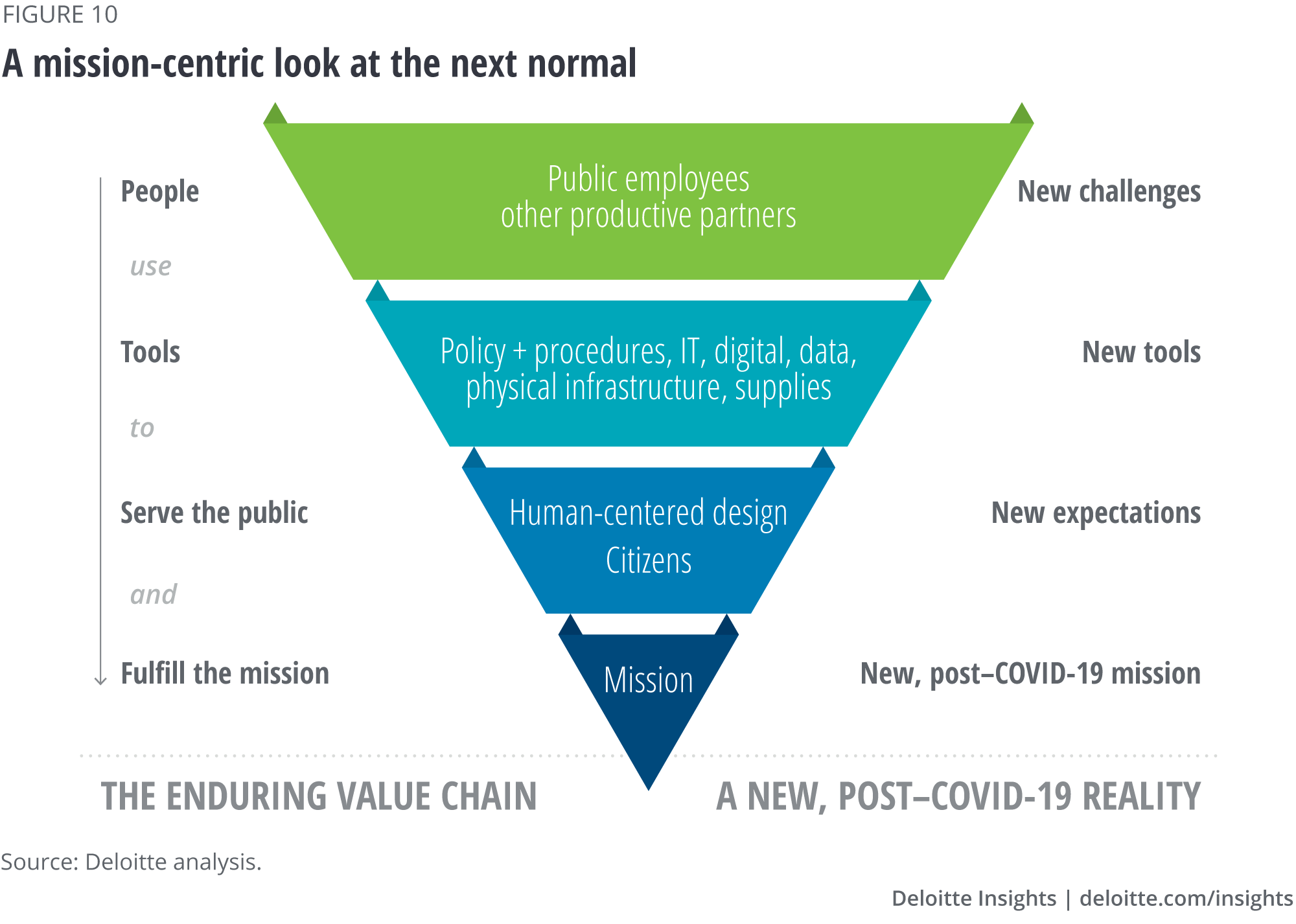
People: Management of public employees as well as other partners of government are likely to be irrevocably changed. In the Recover phase, safeguarding the health and safety of public employees will likely be an area of emphasis, as well as optimizing the use of remote work.
Tools: The COVID-19 crisis has demonstrated clearly that rules and regulations that hinder public service should be altered or removed—quickly. We’ve also seen the importance of data and digital tools to adaptive government.
Serve the public: Expectations for service will only grow after the COVID-19 crisis. In the short term, governments must be able to sense and react rapidly to changes in the pandemic.
Mission: In many cases, government’s mission in a post-COVID environment will be different, as functions such as disease monitoring, regulation of social distancing edicts in shops and retail, and other new tasks will need to be taken up.
Tools and tips
Reassess the mission in a post-COVID environment. From health to social services, from transportation to IT, we’ll be living in a new world, and many parts of government will need to pick up responsibilities related to pandemic monitoring and management.
Communicate. Getting back to normal won’t be easy for anyone, and the public may be confused by changes due to COVID-19. They are likely to wonder, for example, if there will be changes in service offerings or office hours. Transparency can help build understanding while services slowly come back to acceptable levels.
Put people ahead of red tape. During the recovery, mission fulfillment can be enhanced by reexamining and adjusting normal policies, rules, and procedures. In the United States, for instance, states have temporarily waived in-state credentialing requirements for doctors to combat COVID-19. Similar waivers could be offered in procurement or the assessment of innovations that can improve service.
Agility will be more important than ever. The impact of COVID-19—including the stress, fear, and uncertainty—is unlikely to end quickly. This will be a journey, with the possibility of retrenchments if the virus returns.
Leadership in the Recover phase
As the immediate crisis recedes and governments begin returning to normal conditions, government leaders’ jobs will change. They should focus on communicating across boundaries—between government and industry and not-for-profits, between layers of government, and among various agencies. The self-interest of different players may be put aside during the crisis, but during recovery, political considerations and different interests will reemerge.
Government leaders should also play a critical communication role in cutting through the noise of social media, differing rates of recovery, and potential setbacks to foster citizen confidence and trust that it is safe to reengage with the larger community. This trust will be essential to widespread recovery.
While the focus may shift toward the economy and the business of government, data-driven vigilance must continue to ensure that additional waves of the virus do not catch regions unaware. A dashboard of both medical and economic indicators, for instance, can help track progress throughout recovery.
Thrive: Toward the “next normal”
As the pandemic recedes and the economy recovers, the opportunity will arise to go beyond “getting back to normal.” Government will be advancing to the next normal, with operations marked by greater preparedness for a future pandemic and greater overall agility in delivering critical services. The actions government takes during the Thrive phase can set the foundation for enhanced performance, sustained economic growth, and increased resilience long after the pandemic ends.
One reasonable expectation is that governments will use digital tools more often and in more comprehensive ways. Technologies such as AI, blockchain, and the cloud will become integral to government business and the way it interacts with the public. And greater use of certain technologies will make governments less dependent on physical locations and more resilient to any future crisis.
While we’ve looked at the Respond and Recover phases as they will play out along the three fronts of the crisis—health care, the economy, and the business of government—the Thrive phase will be much more about how government establishes a platform for future success in these areas. The Thrive phase is hence aspirational, imagining a future where government builds a platform to create a more resilient health system, a stronger economy, and a more adaptive government. We will look at that possible future by exploring five imperatives for a resilient government—principles that can guide government into a better future.
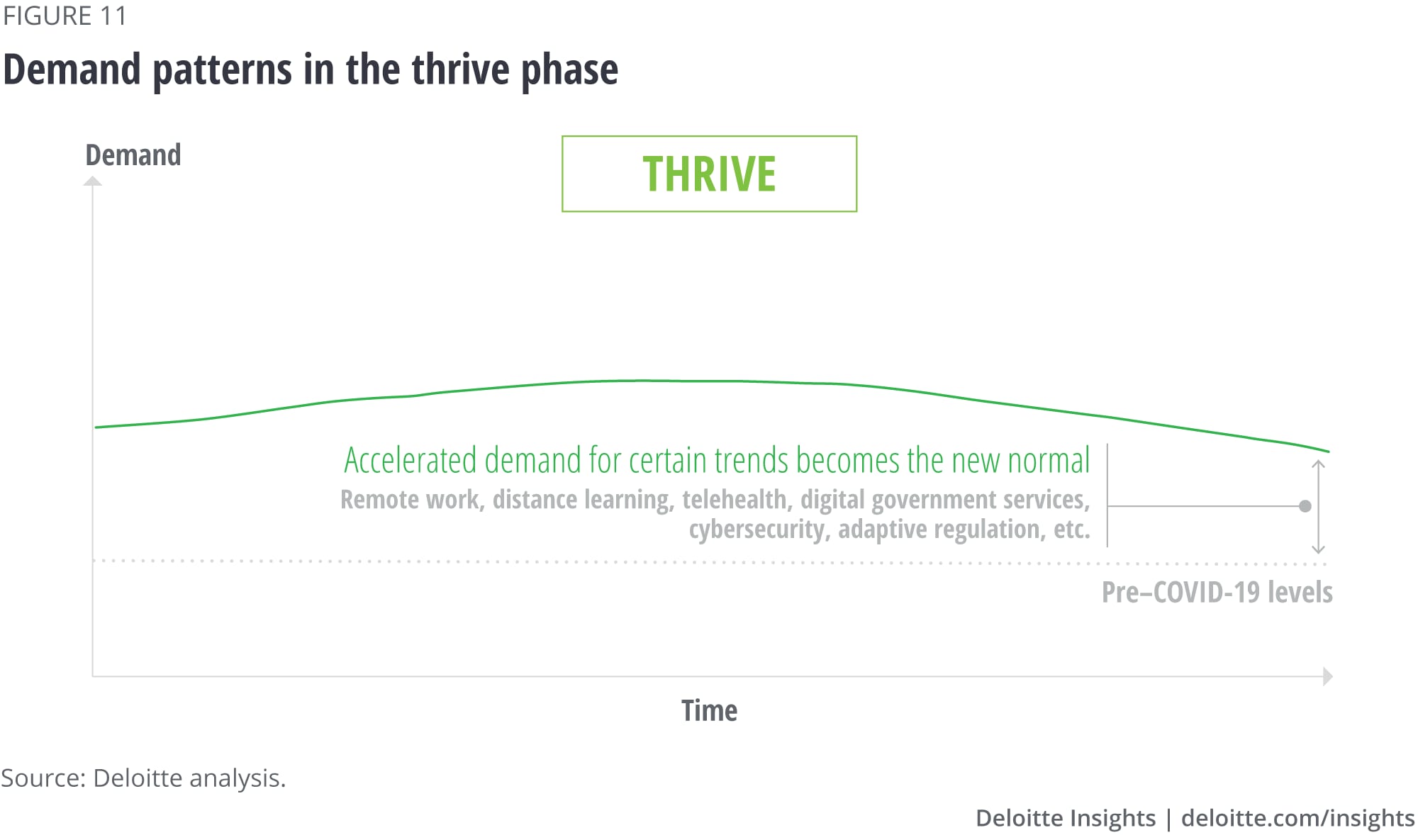
Five imperatives for resilient government during the Thrive phase
Agility
Agility in the Thrive phase focuses on longer-term flexibility and intentional change-making within government. It’s about building skills that governments can deploy not only in a crisis but at all times.
The COVID-19 crisis offers a number of examples of governments displaying agility with workforce management—reassigning workers to overloaded areas such as health care and employment, relaxing hiring regulations, and using the full force of digital technology to adapt to virtual workspaces. While necessary in a crisis, such measures also offer opportunities to reexamine legacy processes with the aim of improved efficiency and resiliency.
This could mean a future in which enhanced digital capabilities allow governments to match people with surges in demand for certain skills. Some government programs, such as NASA’s Talent Marketplace and Canada’s Free Agent Program, have already put this into practice to various degrees.48 With virtual workplaces, people can move to areas of great need almost instantly, become trained faster, and work smarter.
Two-gear government
Governments emerging from COVID-19 will have to divide their resources, managing existing operations on the one hand while also exploring ways to improve future responses.
The crisis has exposed gaps in the procurement of essential medical supplies. While rapid responses are helping to fill gaps, in the long term, governments will need to improve their procurement strategies, which should be smart, agile, open, and resilient. Some governments are farther advanced than others in this regard. In Colombia, for example, the National Health Institute is using e-procurement platforms and open procurement databases.49 In Chile, supply chains now include innovative partnerships with businesses and citizens.50
Governments are selectively relaxing certain regulations on hospitals, pharmaceutical companies and other businesses. In the long term, however, regulators must anticipate disruptions and aim to keep their regulations relevant. The International Coalition of Medicines Regulatory Authorities plans to set up horizon-scanning capabilities to anticipate disruptions caused by emerging technologies. The coalition has established an innovation network to develop globally acceptable approaches for regulating emerging technologies.51
Anticipatory government
Data analytics, AI, scenarios, and simulations allow governments to target likely problems before they erupt and shift the focus from cleaning up problems to preventing them.
Forecasting the consequences of “black swan” events such as pandemics will be a top priority for governments in the Thrive phase. Predictive analytics could track trends and identify events at the earliest possible stage. Complementary tools can be used to run simulations on responses and their second- and third-order effects. Infectious disease surveillance infrastructures could track contacts, scan for fevers, and collect early warning signs of an outbreak, while AI systems could interpret the outbreak’s severity and extent. Genomic techniques could be used to understand new viruses and their mechanisms.
Governments already use predictive technology to stem human trafficking, reduce pollution, improve traffic flows, prepare for natural disasters, and detect tax fraud. But they still lag behind technology companies in terms of how quickly they can alter and update their services. The COVID-19 crisis should lead to a major push by governments to scale and embed anticipatory capabilities into the core of their operations.
Accelerated digital government
Digital services proved essential in the early stages of the COVID-19 crisis. As governments move into the Thrive phase, they should focus on making longer-term improvements to these services, with special attention to infrastructural gaps exposed during response and recovery.
Governments may follow the example of Estonia and other European countries that are moving in the direction of “once-only government”: one-stop, single-point services in which all citizen-government interactions—applying for unemployment, renewing health insurance, or registering for retraining programs—can be conducted with a single digital identification.52 Such interactions can take place anytime and anywhere. Some services can even be provided automatically, in what is termed “no-touch government.”
Swedish taxpayers, for instance, receive a prefilled tax return prepared from income statements from employers and banks, reducing the time they must devote to tax filings.53 In Austria, the birth of a child automatically triggers the transfer of information from the hospital to the central civil registry; from there, it moves to the finance ministry, which passes it on to local tax offices.54
Uninterrupted data connectivity and data-sharing can help governments provide a seamless citizen experience. Naturally, as more citizen services go online, cybersecurity will become a bigger concern, and ultimately a part of government DNA through all processes and products.
Execution by network
A major crisis requires a network of problem-solvers. Technology companies, universities, research labs, and other experts can contribute to collective intelligence that exponentially increases government’s ability to mitigate a crisis.
Such partnerships can help governments respond better to unfolding catastrophes. In recent weeks, several governments have engaged private firms to accelerate the availability of COVID-19 testing kits, N95 masks, respirators, and ventilators.55 One example of such a program is the World Food Programme (WFP) Accelerator, which builds solutions to hunger by tapping a global network of experts and funding promising startups. The program has partnered with academic institutions and United Nations sister agencies as well as private players. One notable product of these efforts is a blockchain-powered transfer system in Pakistan’s Sindh province that facilitates cash transfers to refugees.56
Similarly, to provide financial aid to underserved areas, the United Nations joined forces with Mastercard to establish the infrastructure needed to manage and track funds. Mastercard’s core capabilities, such as fraud detection, electronic tracking, digital infrastructure, and marketing, proved extremely helpful in aid disbursement.57
Over time, governments can act as integrators or conveners to maintain these partnerships, much as venture capitalists use networks to assemble talent. This model brings government closer to technical and scientific innovation, and therefore helps agencies become more familiar with new tools as they emerge.
Data: The foundation for resilient government
Without data, signals that lead to responses are never triggered. Without data, there’s no shared understanding to align a network or guide resource allocation. Digital government creates rapid response capability but also generates the real-time data needed to enable anticipatory government.
Leadership in the Thrive phase
The health crisis is over, and the economy has been stabilized. What now?
To thrive postcrisis, leaders should embrace the long view and ensure that the opportunity to invest in resiliency and improve the public sector—that is, to better position it to deal with future crises—isn’t wasted. We’ve seen numerous examples of governments using digital technologies to provide human-centered services to ease their path through the crisis. In short, the more digital and citizen-centric the government, the better for those it serves.
From crisis to a better future
The COVID-19 crisis is first and foremost a global humanitarian crisis. Having existed for just a few short months, the virus has caused immense human suffering, brought the global economy to a standstill, and challenged governments around the world in a way rarely seen in history. We have seen the devastation when health care capacity has been overwhelmed by the exponential spread of this virus—the tragic loss of life. We have also witnessed a heroic response, showing individuals, societies, and governments taking dramatic steps to turn the tide.
The public sector has been the focal point of the fight against COVID-19, from mandating social distancing to building hospitals, to working with industry to deliver needed medical equipment, to delivering economic relief to impacted individuals. We have seen governments act quickly and decisively, belying the stereotype of the slow-moving bureaucracy. Government has waived regulations and convened a network of scientists, companies, and universities to develop treatments and possible vaccines. While the response has been uneven in different parts of the world, we have seen countless examples of how quickly and decisively government can act in a crisis.
The journey ahead will not be easy. In battling the spread of the disease, the global economy has been brought to a near standstill. This is a new and tricky virus, which spreads readily and produces dire symptoms in only some of those infected, further enabling its spread. In the months ahead, this silent killer may continue to deliver deadly flare-ups that threaten to overwhelm care facilities—and further impede the economy’s ability to bounce back. Moreover, the economic turndown has decimated government revenues even as demand for services has soared. It is a triple crisis, targeting our health, our economy, and our governments. But government has the tools to guide society through the crisis’s inevitable phases: Respond, Recover, and Thrive.
© 2021. See Terms of Use for more information.
More on COVID-19
-
Connecting for a resilient world From Deloitte.com
-
Potential implications of COVID-19 for the insurance sector Article5 years ago
-
COVID-19 and the investment management industry Article5 years ago
-
COVID-19 potential implications for the banking and capital markets sector Article5 years ago
-
The economic impact of COVID-19 (novel coronavirus) Article5 years ago
-
A view from London Article5 days ago















